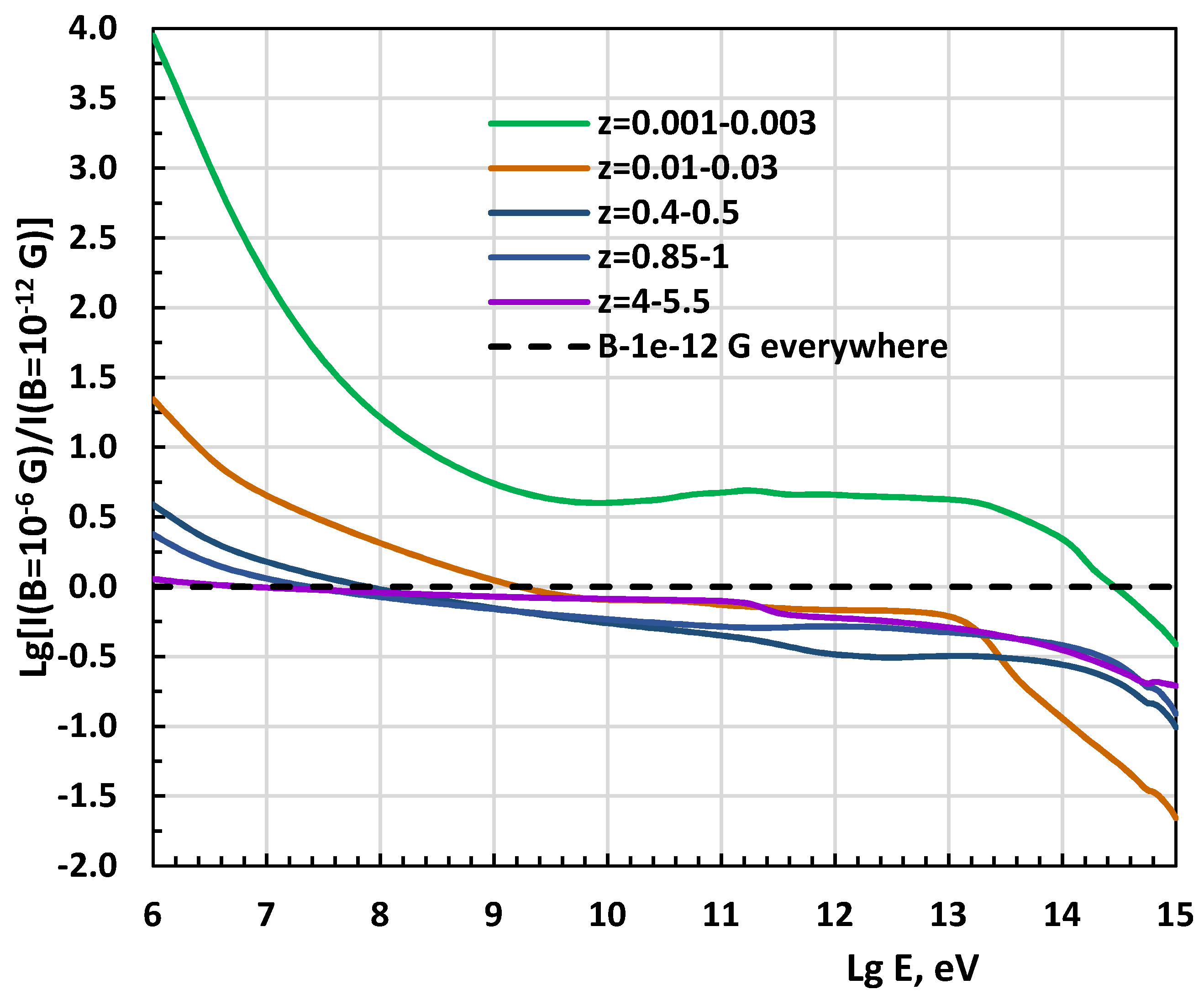Influence of Extragalactic Magnetic Fields on Extragalactic Cascade Gamma-Ray Emission
Abstract
:1. Introduction
2. Model
3. Results and Discussion
4. Conclusions
Funding
Institutional Review Board Statement
Informed Consent Statement
Acknowledgments
Conflicts of Interest
References
- Greisen, K. End to the Cosmic-Ray Spectrum? Phys. Rev. Lett. 1966, 16, 748. [Google Scholar] [CrossRef]
- Zatsepin, G.T.; Kuz’min, V.A. Upper Limit of the Spectrum of Cosmic Rays. JETP Lett. 1966, 4, 78. [Google Scholar]
- Hayakawa, S. Electron-Photon Cascade Process in Intergalactic Space. Prog. Theor. Phys. 1966, 37, 594. [Google Scholar] [CrossRef]
- Prilutsky, O.; Rozental, I.L. Cascade processes in the metagalaxy. Acta Phys. Hung. Suppl. 1970, 129, 51. [Google Scholar]
- Berezinsky, V.S.; Bulanov, S.V.; Dogiel, V.A.; Ginzburg, V.L.; Ptuskin, V.S. Astrophysics of Cosmic Rays; Ginzburg, V.L., Ed.; North-Holland, Elsevier Science Publishers B.V.: Amsterdam, The Netherlands, 1990. [Google Scholar]
- Berezinsky, V.; Kalashev, O. High-energyelectromagnetic cascades in extragalactic space: Physics and features. Phys. Rev. D 2016, 24, 023007. [Google Scholar] [CrossRef] [Green Version]
- Uryson, A.V. Identification of extragalactic cosmic-ray sources using data from various detection facilities. JETP 1998, 86, 213. [Google Scholar] [CrossRef]
- Dolag, K.; Grasso, D.; Springel, V.; Tkachev, I. Constrained simulations of the magnetic field in the local Universe and the propagation of ultrahigh energy cosmic rays. JCAP 2005, 01, 009. [Google Scholar] [CrossRef] [Green Version]
- Elyiv, A.; Neronov, A.; Semikoz, D.V. Gamma-ray induced cascades and magnetic fields in the intergalactic medium. Phys. Rev. D 2009, 80, 023010. [Google Scholar] [CrossRef] [Green Version]
- Abbasi, R.U.; Abe, M.; Abu-Zayyad, T.; Allen, M.; Azuma, R.; Barcikowski, E.; Belz, J.W.; Bergman, D.R.; Blake, S.A.; Cady, R.; et al. TA collaboration. Evidence for a Supergalactic Structure of Magnetic Deflection Multiplets of Ultra-high-energy Cosmic Rays. Astrophys. J. 2020, 899, 86. [Google Scholar] [CrossRef]
- Dzhatdoev, T.A.; Podlesnyi, E.I.; Vaiman, I.A. Can we constrain the extragalactic magnetic field from very high energy observations of GRB 190114C? Phys. Rev. D 2020, 102, 123017. [Google Scholar] [CrossRef]
- Govoni, F.E.; Orrù, E.; Bonafede, A.N.; Iacobelli, M.; Paladino, R.; Vazza, F.R.; Murgia, M.A.; Vacca, V.A.; Giovannini, G.; Feretti, L.; et al. A radio ridge connecting two galaxy clusters in a filament of the cosmic web. Science 2019, 364, 981. [Google Scholar] [CrossRef] [PubMed] [Green Version]
- Roszkowski, L.; Sessolo, E.M.; Trojanowski, S. WIMP dark matter candidates and searches-current status and future prospects. Rep. Prog. Phys. 2018, 81, 066201. [Google Scholar] [CrossRef] [PubMed]
- Fargion, D.; Mele, B.; Salis, A. Ultra-High-Energy Neutrino Scattering onto Relic Light Neutrinos in the Galactic Halo as a Possible Source of the Highest Energy Extragalactic Cosmic Rays. ApJ 1999, 517, 725. [Google Scholar] [CrossRef] [Green Version]
- Fargion, D.; Colaiuda, A. Gamma rays precursors and afterglows surrounding UHECR events: Z-burst model is still alive. Nucl. Phys. B. Proc. Suppl. 2004, 136, 256. [Google Scholar] [CrossRef] [Green Version]
- Fargion, D.; Oliva, P. Updated Z-Burst Neutrinos at Horizons. Nucl. Phys. B (Proc. Suppl.) 2007, 165, 116. [Google Scholar] [CrossRef] [Green Version]
- Fargion, D.; D’Armiento, D.; Paggi, P. UHECR bending, clustering and decaying feeding gamma anisotropy. IL Nuovo Cim. 2013, 36, 139. [Google Scholar]
- Kalashev, O.E.; Kido, E. Simulations of ultra-high-energy cosmic rays propagation. JETP 2015, 120, 790. [Google Scholar] [CrossRef] [Green Version]
- Istomin Ya, N.; Gunya, A.A. Acceleration of high energy protons in AGN relativistic jets. Phys. Rev. D 2020, 102, 043010. [Google Scholar] [CrossRef]
- Uryson, A.V. Identification of sources of ultrahigh energy cosmic rays. Astron. Rep. 2001, 45, 591. [Google Scholar] [CrossRef]
- Krymskii, G.F. A regular mechanism for the acceleration of charged particles on the front of a shock wave. Soviet Physics—Doklady 22 327. Akad. Nauk. SSSR Doklady. 1977, 234, 1306. [Google Scholar]
- Bell, A.R. The acceleration of cosmic rays in shock fronts – I. MNRAS 1978, 182, 147. [Google Scholar] [CrossRef] [Green Version]
- Cesarsky, C.J. Cosmic rays with E > 10**19-eV: Origin and transport. Nucl. Phys. B (Proc. Suppl.) 1992, 28, 51. [Google Scholar] [CrossRef]
- Giacinti, G.; Kachelrieß, M.; Kalashev, O.; Neronov, A.; Semikoz, D.V. Unified model for cosmic rays above 1017 eV and the diffuse gamma-ray and neutrino backgrounds. Phys. Rev. D 2015, 92, 083016. [Google Scholar] [CrossRef] [Green Version]
- Protheroe, R.J.; Biermann, P.L. A new estimate of the extragalactic radio background and implications for ultra-high-energy γ-ray propagation. Astropart Phys. 1996, 6, 45, 1997, 7, 181(E). [Google Scholar]
- Inoue, Y.; Inoue, S.; Kobayashi, M.A.; Makiya, R.; Niino, Y.; Totani, T. Extragalactic background light from hierarchical galaxy formation: Gamma-ray attenuation up to the epoch of cosmic reionization and the first stars. Astrophys. J. 2013, 768, 197. [Google Scholar] [CrossRef]
- Ginzburg, V.L.; Syrovatskii, S.I. The Origin of Cosmic Rays; Massey, H.S.H., Ter Harr, D., Eds.; Pergamon Press: Oxford, UK; Macmillan: London, UK, 1964. [Google Scholar]
- Uryson, A.V. The possibility of investigating ultra-high-energy cosmic-ray sources using data on the extragalactic diffuse gamma-ray emission. Astron. Lett. 2017, 43, 529. [Google Scholar] [CrossRef] [Green Version]
- Dzhatdoev, T.; Khalikov, E.; Podlesnyi, E.; Telegina, A. Intergalactic γ-ray propagation: Basic ideas, processes, and constraints. J. Phys. Conf. Ser. 2019, 1181, 012049. [Google Scholar] [CrossRef]


Publisher’s Note: MDPI stays neutral with regard to jurisdictional claims in published maps and institutional affiliations. |
© 2022 by the author. Licensee MDPI, Basel, Switzerland. This article is an open access article distributed under the terms and conditions of the Creative Commons Attribution (CC BY) license (https://creativecommons.org/licenses/by/4.0/).
Share and Cite
Uryson, A. Influence of Extragalactic Magnetic Fields on Extragalactic Cascade Gamma-Ray Emission. Universe 2022, 8, 569. https://doi.org/10.3390/universe8110569
Uryson A. Influence of Extragalactic Magnetic Fields on Extragalactic Cascade Gamma-Ray Emission. Universe. 2022; 8(11):569. https://doi.org/10.3390/universe8110569
Chicago/Turabian StyleUryson, Anna. 2022. "Influence of Extragalactic Magnetic Fields on Extragalactic Cascade Gamma-Ray Emission" Universe 8, no. 11: 569. https://doi.org/10.3390/universe8110569



